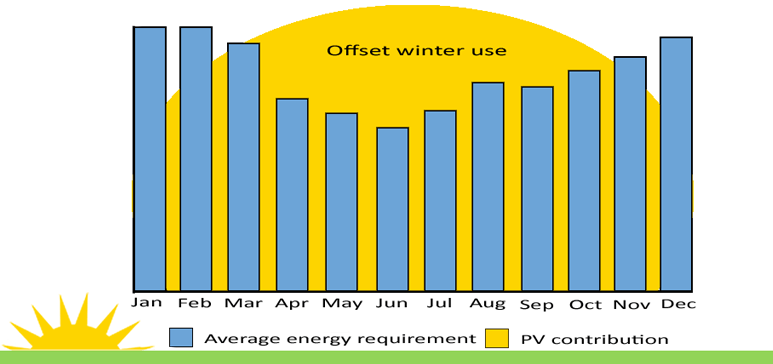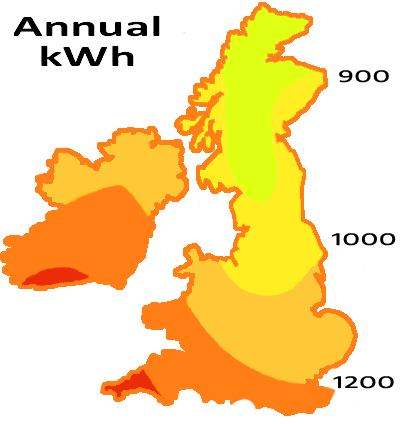

Domestic solar panels in the UK
Contrary to general belief, solar panels generate on most cloudy days and work more efficiently in moderate temperatures and climates. The UK receives 60% of the sun's radiation compared to the equatorial regions. Domestic solar panels could reduce energy bills by around 70%, depending on the system size and ancillary storage options.

"I find myself evangelical in my enthusiasm for solar panels, and will extol its virtues at the drop of a hat and have already recommended the technology to family and friends."
Mrs. Beverage, Stoke-on-Trent.

Solar panels can generate in certain diffused light conditions. Each square metre of the UK receives between 900-1400 kWh annually. Spring, summer, and early autumn should generate most of your requirements, and a percentage in the winter months. Each case is different, but as a general guide, approximately 750kWh/year per kW.
The benefits of installing solar technologies:
- Improved and new ancillary technologies.
- Be the first on your street and encourage others to follow your lead.
- A possible and notable increase in your property value.
- Increase energy efficiency ratings.
- Energy independence-ish.
- Money in the bank offers smaller returns.
Common questions about solar panels
Solar heating or PV?
In the early 2000s, solar heating was king, and PV was excessively expensive. By 2010, standards and regulations brought the industry much-needed regulation, and installation companies disappeared as quickly as mobile phone providers from that era. Today, thousands of solar installers have sprung up nationwide, offering technologies that vary in cost, efficiency, and value for money.
Do I have to install solar panels on a roof?
A-frames or outbuildings with suitable roofing can be used. Transfer resistance dictates that shorter wire and pipe runs are best.
Is my roof suitable for solar panels?
Anything between South, South West, and South East is best for solar panels. East and West split is possible. If you don't have a suitable roof, consider an A-framed solution.
Extend the life of a boiler.
Solar heating keeps hot water in a well-insulated storage tank for most of the year. This system extends the life span of a boiler.
On-grid or off-grid?
When PV (Photovoltaic) solar panels produce electricity, you can use it, store it, or feed it out to the National Grid. On-grid means getting paid for surplus power. Export tariff schemes offer remuneration for power not stored or consumed.
Off-grid systems may be beneficial for people who rent their homes and who want to take their system away at the end of a tenancy. On-grid cannot be self-installed, but off-grid systems can be.
What is the solar heating output?
Solar heat delivery is 900-1400 kWh (3.6 GJ) of useable energy (depending on geographical location) as hot water per year. Peak output is 1.6 kW, similar to an immersion heater. Performance varies per household consumption, microclimate, and geographical location. A hot water tank has to stay above 60 degrees Celcius to prevent legionella, which means your primary heating method is constantly in use. On summer days, possible temperatures of 75C can be achieved (45C hot enough for bathing), but dependent on location and the type of system installed.
Your boiler or immersion heater use will decrease dramatically.
Any ongoing maintenance?
For peak performance, a periodic clean every few years with an inverter replacement every ten to fifteen years. Solar heating requires routine pressurisation checks by the owner. Modern PV systems come with performance-tracking apps. A five-yearly clean would keep prime performance. In the case of solar heating, periodic checks every 3-4 years to check PH levels of Glycol antifreeze.
What type of solar heating panel is best?
Usually, a flat panel salesperson will say his system performs best, and solar tube salesmen will say the same. Through decades of experience, I've concluded that evacuated tubes perform best.
Do I need planning permission?
No. From 6 April 2008, planning permission was no longer required unless for a listed building.
Can you install solar panels on flat roofs?
A-frame at 20 and 50 degrees from horizontal.
Will they replace bills entirely?
No, you can't replace your primary energy supply, but you can add a secondary using solar panels with ancillary storage technologies.
Domestic solar panels will get cheaper, won't they?
Unfortunately, the indicators are that prices will rise. As a 2010 Financial Times article points out, the rising cost of manufacture. Likely, solar panels will never be cheaper than they are now. That article was proven correct in modern times.
Can solar panels replace all my energy bills?
No. You won't be able to replace it totally, but you can expect free electricity, hot water, and vehicle mileage for most of the year.
What about selling surplus power?
Remuneration for surplus power arrives via an export tariff. The export tariff scheme was a breakthrough for solar adopters in 2016 onward. They allowed self-generators to sell and offset power before battery storage became popular.
Solar panels and battery storage?
Depends on the consumption rate and the size of the PV system installed. Battery storage retains 80% charging capacity after twenty years.
Can solar panels run my central heating?
This answer depends on the type of heating system and heating management system. Tank storage and solar heating can contribute to central heating with a secondary coil, but not all solar installation companies offer this technology. PV with a heat converter is also available for immersion heaters.
Can solar panels charge my electric car?
Many homeowners installed PV systems over the last decade because it bestowed a pioneering status. The next logical step is to trade in your old gas guzzler for an EV (electric vehicle) charged for free with solar panels. This technology does give free motor mileage.
How long do photovoltaic solar panels last?
Many PV solar panels installed in the 1960s are still generating today. Expect 80% generating capacity remaining after twenty years, including a manufacturer's warranty of ten years. A three-decade lifespan is standard.
How does solar heating benefit?
50% of solar systems installed in Germany, Austria, Switzerland, Denmark, and Norway were to supply space heating systems, while in Sweden and Canada, it was more. These countries have a similar solar exposure to the UK.
Solar heating extends the lifespan of your boiler because your boiler won't fire up as often. On sunny days, temperatures of 80 Celcius can be achieved (45 Celcius is hot enough for bathing.) This temperature is dependent on geography and the type of system installed.
Do solar panels add value to my property?
A 2009 survey by MORI found people are willing to pay more for a solar-equipped home.
Can I self-install solar panels?
PV export tariff-eligible systems are to be certified by accredited MCS PV solar installers. Off-grid PV systems and solar heating systems are available as DIY solar panel kits.
Do I need to clean solar panels?
Solar panels have a self-cleaning glass surface. However, depending on your location, you and maybe more prone to tree resin, urban dust, moss growth, or bird poo. If this is an issue, then most window or gutter cleaners can help.
How much do solar panels cost?
Domestic solar panel systems come in different sizes and a variety of different costs and configurations. Let's discuss your options.
New worldr savvy.
"I've witnessed many fantastic changes, innovations, and installation companies come and go. My fellowship with ethically-minded MCS solar panel installers goes back decades. Today, I offer my experience to ensure you gain real independence from this crazy geopolitical world."
Stuart Lovatt
Power My Home Solar Panels
Sundial House, 44 Panton Road, Chester CH2 3HX.
01244 722 607
Est. 2004.